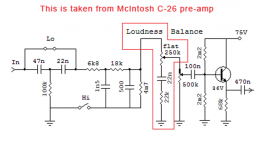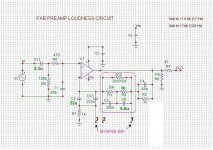I have found out that for best performance, I have to correct bass level according to sound level on my system.
On the other hand, this is very unpractical an non-optimal. I could use an normal loudness control, but I don't find them working good!
Loking on the sensitivity curves for the ears tells that a level dependent bass eq is needed, but not eq in the rest of the spectrum. I think it is why I dont like ordanary loudness controls.
There are two basic things to look for:
1. Automatic bass correction with volume setting
2. Level control, to fit to system
The first could be a normal loudness potentiometer with only bass correction
The second could be a second volumecontrol
Anybody know about these problems and have some circuits?
On the other hand, this is very unpractical an non-optimal. I could use an normal loudness control, but I don't find them working good!
Loking on the sensitivity curves for the ears tells that a level dependent bass eq is needed, but not eq in the rest of the spectrum. I think it is why I dont like ordanary loudness controls.
There are two basic things to look for:
1. Automatic bass correction with volume setting
2. Level control, to fit to system
The first could be a normal loudness potentiometer with only bass correction
The second could be a second volumecontrol
Anybody know about these problems and have some circuits?
The easiest solution is to use a normal pot and simply listen at the intended SPL.
There is only one correct listening level for each recording !
Regards
Charles
There is only one correct listening level for each recording !
Regards
Charles
Independent volume control with loudness and separate " gain " control had Yamaha amps - try to find some manual...
B&O once made (early '70's, dont know about later on) amps which had "loudness" built in to vol control circuitry, IE as you turned down the volume it applied loudness compensation. It could not be defeated so was pretty objectionable!
Loudness compensation
I urge you to read "Loudness compensation use and abuse" by Holman and Kampman, and to have a look on the Apt Holman preamp. It's of the greatest help on the subject I am aware.
I urge you to read "Loudness compensation use and abuse" by Holman and Kampman, and to have a look on the Apt Holman preamp. It's of the greatest help on the subject I am aware.
phase_accurate said:The easiest solution is to use a normal pot and simply listen at the intended SPL.
There is only one correct listening level for each recording !
Regards
Charles
I agree completely....there is only one correct level at reproduction of a recording.
But my idea was to be able to use more levels but adjusting the eq....
I think a major reason for not listening at lower levels, is the thin sound.
Re: Loudness compensation
Is there any related material available online ? Even schematics ? Because I'm not very sure if I can get that book. It's a book, right ?
I agree that there is only one correct level, but some of us are sometimes forced to listen at low level and I too find typical loudness circuits not satisfying.
forr said:I urge you to read "Loudness compensation use and abuse" by Holman and Kampman, and to have a look on the Apt Holman preamp. It's of the greatest help on the subject I am aware.
Is there any related material available online ? Even schematics ? Because I'm not very sure if I can get that book. It's a book, right ?
I agree that there is only one correct level, but some of us are sometimes forced to listen at low level and I too find typical loudness circuits not satisfying.
The Heathkit AP-1800 preamp (ca. 1979) was extremely full-featured - seperate bass and treble for left and right, variable turnover, bunch of filters, etc.
Although it didn't sound all that good, it did have a variable loudness circuit (separate pot) with an active circuit. The circuit description did include a reference to "newer" curves than the Fletcher-Munson equal loudness curves (the ones that made everyone believe that only bass compensation was required).
Although it didn't sound all that good, it did have a variable loudness circuit (separate pot) with an active circuit. The circuit description did include a reference to "newer" curves than the Fletcher-Munson equal loudness curves (the ones that made everyone believe that only bass compensation was required).
There is one thing puzzling me: a loudness circuit attempts to "equalize" the equal loudness curves by using a level-dependant euqlization. However, since the actual sound pressure level depends not only of the output power, but also on the sensitivity of the speakers, it results that the loudness circuit really only "guesses" the level, so it cannot work well with every speaker, unless you can set a sensitivity parameter.
Am I making sense ?
Am I making sense ?
bzfcocon said:There is one thing puzzling me: a loudness circuit attempts to "equalize" the equal loudness curves by using a level-dependant euqlization. However, since the actual sound pressure level depends not only of the output power, but also on the sensitivity of the speakers, it results that the loudness circuit really only "guesses" the level, so it cannot work well with every speaker, unless you can set a sensitivity parameter.
Am I making sense ?
Yes....
Thats why I want a loudness circuit who is controlled by the volumecontrol (as in old timers) AND a linear level control (extra volume) to set the correct level.....
CharleyW said:The Heathkit AP-1800 preamp (ca. 1979) was extremely full-featured - seperate bass and treble for left and right, variable turnover, bunch of filters, etc.
Although it didn't sound all that good, it did have a variable loudness circuit (separate pot) with an active circuit. The circuit description did include a reference to "newer" curves than the Fletcher-Munson equal loudness curves (the ones that made everyone believe that only bass compensation was required).
Analysing the Fletcher-Munson curves shows that it is mainly a bass compensation that is needed....as it is only in that area that the hearing is changed by level....in the higher frequencies the level is relative constant relative to the level....and therefore no levelcompensation is needed....
A question:
At what level is a typical concert recording made? 90dB? 100DB?
bzfcocon said:There is one thing puzzling me: a loudness circuit attempts to "equalize" the equal loudness curves by using a level-dependant euqlization. However, since the actual sound pressure level depends not only of the output power, but also on the sensitivity of the speakers, it results that the loudness circuit really only "guesses" the level, so it cannot work well with every speaker, unless you can set a sensitivity parameter.
Am I making sense ?
All properly calibrated THX preamp/processors are setup such that 0dB on the volume knob causes 0dBFS to produce 105dB SPL at the listening position.
Lexicon preamp/processors exploit this to provide a SPL dependant loudness function.
Our ears are tuned to mid-frequencies not the lo's and hi's. The sensitivity drops as we aged that's why the variable loudness control comes to play. I usually adjust it to a level I like at low volume and flat it at high level.
Fisher solid state amps from the 80's use to have a loudness button you could leave on as the amount of boost decreased as the volume increased to the point where switching it back and forth made no difference.
I always thought that's how loudness isi supposed to work: volume-dependent , although the correct thing would be SPL-dependent.
The others I have dealt with were a constant boost and you had to get up (before remotes) to change it when you turned it up. I just remember liking that feature of the Fisher.
Mind you, I think I have only 3 amps that have a loudness button anyway and haven't used it for quite some time.
Mind you, I think I have only 3 amps that have a loudness button anyway and haven't used it for quite some time.
Variable Loudness circuit
I agree that the loudness setting has to be independently adjusted from the volume pot.
I also compensate for bad recordings where the bass has been forgotten...
This is the circuit I have come up with after several audio trials. It only increases the bass frequency gain. The main advantage of the circuit is that it is incorporated in the feedback path of your actual pre-amp so no need for additional active circuit. It can also be bypassed using a switch between connections 1 and 3 when not needed so no feedback cap in the audio path. The pot is shown as R3+R9 = 20K (linear). R10 is optional and the value can be adjusted if the pot value you have in hands does not provide the required compensation. U1 is shown to represent the active portion of the pre-amp since my real pre-amp circuit use discrete parts and not op-amps.
I agree that the loudness setting has to be independently adjusted from the volume pot.
I also compensate for bad recordings where the bass has been forgotten...
This is the circuit I have come up with after several audio trials. It only increases the bass frequency gain. The main advantage of the circuit is that it is incorporated in the feedback path of your actual pre-amp so no need for additional active circuit. It can also be bypassed using a switch between connections 1 and 3 when not needed so no feedback cap in the audio path. The pot is shown as R3+R9 = 20K (linear). R10 is optional and the value can be adjusted if the pot value you have in hands does not provide the required compensation. U1 is shown to represent the active portion of the pre-amp since my real pre-amp circuit use discrete parts and not op-amps.
Attachments
Skorpio said:At what level is a typical concert recording made? 90dB? 100DB?
It's not what level is a recording made at, more a case of what is the level when it is mixed in the studio, and that will depend on the personal preferences of the engineer and producer.
- Status
- Not open for further replies.
- Home
- Amplifiers
- Solid State
- Loudness experiences?


